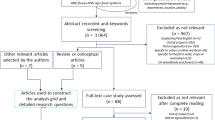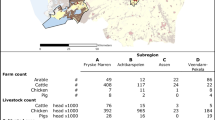Abstract
Circularity is a new paradigm of nutrient management that seeks to mitigate environmental impacts of agriculture by reducing nutrient losses through reuse. However, circular nutrient management is not a goal in itself, but rather a means of transition to sustainable food systems. We argue for a conceptually stronger and more explicit combination of circularity strategies with efficiency and sufficiency. To this end, we combine these three transition strategies into a conceptual framework that accounts for the relationship between them. An example of regional N flows is used to quantify the systemic effects of each strategy. Results show that circularity does not affect overall system’s efficiency but reduces primarily inputs. Circularity can also lead to rebound effects if reused products have a lower efficiency than the products they replace. Targeting efficiency as a strategy has systemic, non-linear negative effects, as it reduces opportunities for implementation of circular solutions and reuse of nutrients. Sufficiency as a strategy can affect circularity, as a shift towards a more plant-based diet will likely increase nutrient use efficiency, and will therefore reduce the available recoverable nutrients and limit circularity. Moreover, circularity, efficiency and sufficiency as strategies may have different time frames that policy makers and practitioners need to consider in their implementation efforts. Finally, regional nutrient management should aim to combine the three strategies in modelling, planning and decision making.



Similar content being viewed by others
Notes
Ignoring the use of virgin N outside the EU; Leip, A., Caldeira, C., Corrado, S., Hutchings, N.J., Lesschen, J.P., Schaap, M., de Vries, W., Westhoek, H. and van Grinsven, H.J.M. 2022. Halving nitrogen waste in the European Union food systems requires both dietary shifts and farm level actions. Global Food Security 35, 100,648.
We refer here to system level NUE and not to the NUE of a arable production or a crop.
References
Aiking H, de Boer J (2020) The next protein transition. Trends Food Sci Technol 105:515–522. https://doi.org/10.1016/j.tifs.2018.07.008
Allen T, Prosperi P (2016) Modeling sustainable food systems. Environ Manage 57(5):956–975. https://doi.org/10.1007/s00267-016-0664-8
Allievi F, Vinnari M, Luukkanen J (2015) Meat consumption and production—analysis of efficiency, sufficiency and consistency of global trends. J Clean Prod 92:142–151. https://doi.org/10.1016/j.jclepro.2014.12.075
Barbieri P, Pellerin S, Seufert V, Smith L, Ramankutty N, Nesme T (2021) Global option space for organic agriculture is delimited by nitrogen availability. Nature Food 2(5):363–372
Biesbroek S, Kok FJ, Tufford AR, Bloem MW, Darmon N, Drewnowski A, Veer PVT (2023e) Toward healthy and sustainable diets for the 21st century: importance of sociocultural and economic considerations. Proc Natl Acad Sci 120(26):e2219272120. https://doi.org/10.1073/pnas.2219272120
Campbell BM, Beare DJ, Bennett EM, Hall-Spencer JM, Ingram JS, Jaramillo F, Ortiz R, Ramankutty N, Sayer JA, Shindell D (2017) Agriculture production as a major driver of the Earth system exceeding planetary boundaries. Ecol Soc 22(4)
European Comission (2019) Regulation (EU) 2019/1009 of the European Parliament and of the Council of 5 June 2019 laying down rules on the making available on the market of EU fertilising products and amending Regulations (EC) No 1069/2009 and (EC) No 1107/2009 and repealing Regulation (EC) No 2003/2003 (Text with EEA relevance), Brussels
European Commission (2020) Farm to fork strategy—for a fair, healthy and environmentally-friendly food system, European Commission.
Superior Health Council (2019) Dietary recommendations for the Belgian adult population
De Keyser E, Mathijs E (2023) A typology of sustainable circular business models with applications in the bioeconomy. Front Sustain Food Syst 6:1028877
De Meyer A, Cattrysse D, Van Orshoven J (2015) A generic mathematical model to optimise strategic and tactical decisions in biomass-based supply chains (OPTIMASS). Eur J Oper Res 245(1):247–264. https://doi.org/10.1016/j.ejor.2015.02.045
Dijst M, Worrell E, Böcker L, Brunner P, Davoudi S, Geertman S, Harmsen R, Helbich M, Holtslag AA, Kwan M-P (2018) Exploring urban metabolism—towards an interdisciplinary perspective, pp 190–203, Elsevier
Erisman J, Leach A, Bleeker A, Atwell B, Cattaneo L, Galloway J (2018) An integrated approach to a nitrogen use efficiency (NUE) indicator for the food production-consumption chain. Sustainability 10(4):925. https://doi.org/10.3390/su10040925
Fernandez-Mena H, Gaudou B, Pellerin S, MacDonald GK, Nesme T (2020) Flows in agro-food networks (FAN): an agent-based model to simulate local agricultural material flows. Agric Syst 180:102718. https://doi.org/10.1016/j.agsy.2019.102718
Figge F, Thorpe AS, Gutberlet M (2023) Definitions of the circular economy: circularity matters. Ecol Econ 208:107823. https://doi.org/10.1016/j.ecolecon.2023.107823
Giampietro M (2019) On the circular bioeconomy and decoupling: implications for sustainable growth. Ecol Econ 162:143–156. https://doi.org/10.1016/j.ecolecon.2019.05.001
Harder R, Giampietro M, Mullinix K, Smukler S (2021) Assessing the circularity of nutrient flows related to the food system in the Okanagan bioregion, BC Canada. Resour Conserv Recycl 174:105842. https://doi.org/10.1016/j.resconrec.2021.105842
Hutchings N, Nielsen O, Dalgaard T, Mikkelsen M, Børgesen C, Thomsen M, Ellermann T, Højberg A, Mogensen L, Winther M (2014) A nitrogen budget for Denmark; developments between 1990 and 2010, and prospects for the future. Environ Res Lett 9(11):115012
Hutchings NJ, Sørensen P, Cordovil CMDS, Leip A, Amon B (2020) Measures to increase the nitrogen use efficiency of European agricultural production. Glob Food Sec 26:100381. https://doi.org/10.1016/j.gfs.2020.100381
Lassaletta L, Billen G, Grizzetti B, Anglade J, Garnier J (2014) 50 year trends in nitrogen use efficiency of world cropping systems: the relationship between yield and nitrogen input to cropland. Environ Res Lett 9(10):105011
Le Noë J, Billen G, Garnier J (2017) How the structure of agro-food systems shapes nitrogen, phosphorus, and carbon fluxes: the generalized representation of agro-food system applied at the regional scale in France. Sci Total Environ 586:42–55. https://doi.org/10.1016/j.scitotenv.2017.02.040
Leip A, Billen G, Garnier J, Grizzetti B, Lassaletta L, Reis S, Simpson D, Sutton MA, De Vries W, Weiss F (2015) Impacts of European livestock production: nitrogen, sulphur, phosphorus and greenhouse gas emissions, land-use, water eutrophication and biodiversity. Environ Res Lett 10(11):115004. https://doi.org/10.1016/j.gfs.2022.100648
Leip A, Caldeira C, Corrado S, Hutchings NJ, Lesschen JP, Schaap M, de Vries W, Westhoek H, van Grinsven HJM (2022) Halving nitrogen waste in the European Union food systems requires both dietary shifts and farm level actions. Glob Food Sec 35:100648
McGreevy SR, Rupprecht CDD, Niles D, Wiek A, Carolan M, Kallis G, Kantamaturapoj K, Mangnus A, Jehlička P, Taherzadeh O, Sahakian M, Chabay I, Colby A, Vivero-Pol J-L, Chaudhuri R, Spiegelberg M, Kobayashi M, Balázs B, Tsuchiya K, Nicholls C, Tanaka K, Vervoort J, Akitsu M, Mallee H, Ota K, Shinkai R, Khadse A, Tamura N, Abe K-I, Altieri M, Sato Y-I, Tachikawa M (2022) Sustainable agrifood systems for a post-growth world. Nature Sustain 5(12):1011–1017. https://doi.org/10.1038/s41893-022-00933-5
Mekonnen MM, Neale CMU, Ray C, Erickson GE, Hoekstra AY (2019) Water productivity in meat and milk production in the US from 1960 to 2016. Environ Int 132:105084. https://doi.org/10.1016/j.envint.2019.105084
Muller A, Schader C (2017) Efficiency, sufficiency, and consistency for sustainable healthy food. Lancet Planet Health 1(1):e13–e14. https://doi.org/10.1016/s2542-5196(17)30012-8
Muys M, Papini G, Spiller M, Sakarika M, Schwaiger B, Lesueur C, Vermeir P, Vlaeminck SE (2020) Dried aerobic heterotrophic bacteria from treatment of food and beverage effluents: screening of correlations between operation parameters and microbial protein quality. Biores Technol 307:123242. https://doi.org/10.1016/j.biortech.2020.123242
Papangelou A, Mathijs E (2021) Assessing agro-food system circularity using nutrient flows and budgets. J Environ Manage 288:112383. https://doi.org/10.1016/j.jenvman.2021.112383
Papangelou A, Achten WMJ, Mathijs E (2020) Phosphorus and energy flows through the food system of brussels capital region. Resour Conserv Recycl 156:104687. https://doi.org/10.1016/j.resconrec.2020.104687
European Parliament (2023) How the EU wants to achieve a circular economy by 2050. https://www.europarl.europa.eu/news/en/headlines/society/20210128STO96607/how-the-eu-wants-to-achieve-a-circular-economy-by-2050?gclid=CjwKCAjwkLCkBhA9EiwAka9QRm_WrKTsBVjgTRs9jxJjqJAWAEt-TKHFlpDE31_v5mZyGm14q--W2hoCADAQAvD_BwE
Rockström J, Gupta J, Qin D, Lade SJ, Abrams JF, Andersen LS, Armstrong Mckay DI, Bai X, Bala G, Bunn SE, Ciobanu D, Declerck F, Ebi K, Gifford L, Gordon C, Hasan S, Kanie N, Lenton TM, Loriani S, Liverman DM, Mohamed A, Nakicenovic N, Obura D, Ospina D, Prodani K, Rammelt C, Sakschewski B, Scholtens J, Stewart-Koster B, Tharammal T, Van Vuuren D, Verburg PH, Winkelmann R, Zimm C, Bennett EM, Bringezu S, Broadgate W, Green PA, Huang L, Jacobson L, Ndehedehe C, Pedde S, Rocha J, Scheffer M, Schulte-Uebbing L, De Vries W, Xiao C, Xu C, Xu X, Zafra-Calvo N, Zhang X (2023) Safe and just earth system boundaries. Nature. https://doi.org/10.1038/s41586-023-06083-8
Saheb Y (2021) COP26: sufficiency should be first, buildings and cities. https://www.buildingsandcities.org/insights/commentaries/cop26-sufficiency.html
Sigurnjak I, Brienza C, Snauwaert E, De Dobbelaere A, De Mey J, Vaneeckhaute C, Michels E, Schoumans O, Adani F, Meers E (2019) Production and performance of bio-based mineral fertilizers from agricultural waste using ammonia (stripping-)scrubbing technology. Waste Manage 89:265–274. https://doi.org/10.1016/j.wasman.2019.03.043
Spiller M, Moretti M, De Paepe J, Vlaeminck SE (2022) Environmental and economic sustainability of the nitrogen recovery paradigm: evidence from a structured literature review. Resour Conserv Recycl 184:106406. https://doi.org/10.1016/j.resconrec.2022.106406
Tanzer J, Zoboli O, Zessner M, Rechberger H (2018) Filling two needs with one deed: potentials to simultaneously improve phosphorus and nitrogen management in Austria as an example for coupled resource management systems. Sci Total Environ 640–641:894–907. https://doi.org/10.1016/j.scitotenv.2018.05.177
Tur-Cardona J, Bonnichsen O, Speelman S, Verspecht A, Carpentier L, Debruyne L, Marchand F, Jacobsen BH, Buysse J (2018) Farmers’ reasons to accept bio-based fertilizers: a choice experiment in seven different European countries. J Clean Prod 197:406–416. https://doi.org/10.1016/j.jclepro.2018.06.172
van der Wiel BZ, Weijma J, van Middelaar CE, Kleinke M, Buisman CJN, Wichern F (2019) Restoring nutrient circularity: a review of nutrient stock and flow analyses of local agro-food-waste systems. Resourc Conserv Recycl X 3:100014. https://doi.org/10.1016/j.rcrx.2019.100014
Velasco-Muñoz JF, Mendoza JMF, Aznar-Sánchez JA, Gallego-Schmid A (2021) Circular economy implementation in the agricultural sector: definition, strategies and indicators. Resour Conserv Recycl 170:105618
Vingerhoets R, Spiller M, De Backer J, Adriaens A, Vlaeminck SE, Meers E (2023) Detailed nitrogen and phosphorus flow analysis, nutrient use efficiency and circularity in the agri-food system of a livestock-intensive region. J Clean Prod 410:137278. https://doi.org/10.1016/j.jclepro.2023.137278
Vonk J, Bannink A, van Bruggen C, Groenestein CM, Huijsmans JFM, van der Kolk J, Luesink H, Voshaar SO, Sluis S, Velthof GL (2016) Methodology for estimating emissions from agriculture in the Netherlands: calculations of CH4, NH3, N2O, NOx, PM10, PM2.5 and CO2 with the national emission model for agriculture (NEMA), Statutory research tasks unit for nature & the environment
Willett W, Rockström J, Loken B, Springmann M, Lang T, Vermeulen S, Garnett T, Tilman D, Declerck F, Wood A, Jonell M, Clark M, Gordon LJ, Fanzo J, Hawkes C, Zurayk R, Rivera JA, De Vries W, Majele Sibanda L, Afshin A, Chaudhary A, Herrero M, Agustina R, Branca F, Lartey A, Fan S, Crona B, Fox E, Bignet V, Troell M, Lindahl T, Singh S, Cornell SE, Srinath Reddy K, Narain S, Nishtar S, Murray CJL (2019) Food in the Anthropocene: the EAT–lancet commission on healthy diets from sustainable food systems. The Lancet 393(10170):447–492. https://doi.org/10.1016/s0140-6736(18)31788-4
Acknowledgements
The authors would like to acknowledge the contributions of the colleagues of the sustainable, air, energy and water technology research group of the University of Antwerp. Their critical views were invaluable to improving the manuscript.
Funding
The funding was supported by Horizon 2020 (Grant No. 792021), HORIZON EUROPE European Research Council (Grant No. 862849).
Author information
Authors and Affiliations
Contributions
Marc Spiller - conceptualization, methodology, writing - original draft, writing - Review & Editing, Data curation, Visualization, Formal analysis Ruben Vingerhoets - Data curation, Writing - Review & Editing, Siegfried Vlaeminck - Review and Editing Florian Wichern - Conceptualization Anastasia Papangelou - Conceptualization, Formal analysis, Writing - original draft, Review and Editing
Corresponding author
Ethics declarations
Conflict of interest
The authors declare not competing interests.
Additional information
Publisher's Note
Springer Nature remains neutral with regard to jurisdictional claims in published maps and institutional affiliations.
Supplementary Information
Below is the link to the electronic supplementary material.
Rights and permissions
Springer Nature or its licensor (e.g. a society or other partner) holds exclusive rights to this article under a publishing agreement with the author(s) or other rightsholder(s); author self-archiving of the accepted manuscript version of this article is solely governed by the terms of such publishing agreement and applicable law.
About this article
Cite this article
Spiller, M., Vingerhoets, R., Vlaeminck, S.E. et al. Beyond circularity! Integration of circularity, efficiency, and sufficiency for nutrient management in agri-food systems. Nutr Cycl Agroecosyst (2024). https://doi.org/10.1007/s10705-024-10339-8
Received:
Accepted:
Published:
DOI: https://doi.org/10.1007/s10705-024-10339-8




